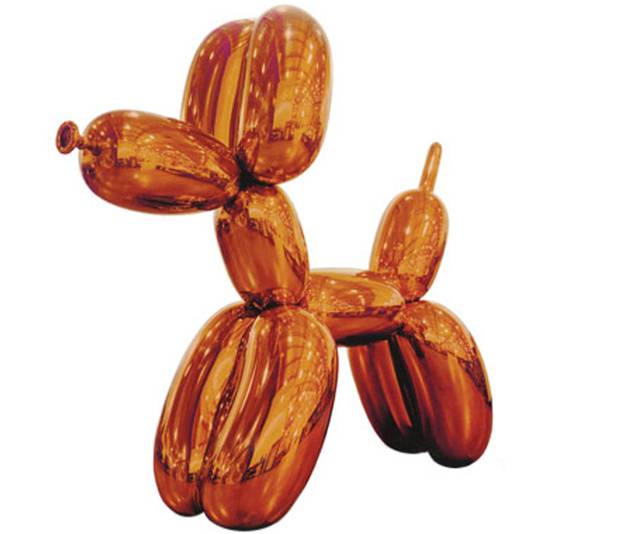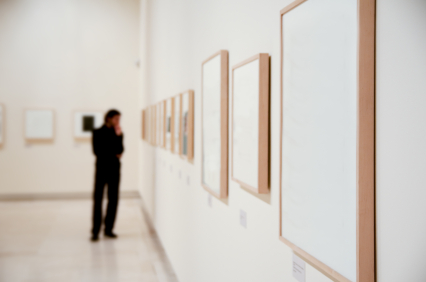Label: records
Friday 19th December 2014All Time Auction Records

Just when you think the art market can't get even more incredibly rich, it does. Despite many predictions that the current auction sale bubble is going to burst, sending all those multimillionaires and billionaires into tears as the value of their precious art collections crumble, the market just keeps getting stronger and stronger. Of course, that's always how things look before a bubble burst, but after the recent contemporary art auction held by Christie's, it's clearly not quite ready to burst just yet.
Only a few days previously, Sotheby's, the primary competitor in auctioneering to Christie's, set a respectable mark at just shy of $344 million USD for contemporary art, including $36 million for a new Jasper Johns record sale price for Flag (1983). Christie's, however, completely blew that figure out of the water with a truly staggering $852.9 million USD mark, spaced across 75 lots.
Figures like these make the working artists among us cringe and salivate at the same time, wishing our pieces would sell for such ridiculously high sums, and bemoaning the fact that the artists never see a penny of these incredible amounts. They do, however, also point out the fact that the art auction market is almost wildly divergent from the actual art world itself, the one where creation and appreciation of art is important for an emotional reason rather than a financial one.
The dealers and speculators who buy and sell works at these prices aren't really buying and selling art in the way that most of us mere mortals think about it, they're effectively trading stock. They don't buy pieces because they appreciate their beauty, or because they like the artist, or because they like the way it makes them feel. They don't even purchase them because they're fashionable - they purchase them because they expect to be able to turn them around in a few years and sell them for even more money. It's not about the art, it's about the perception of value.
So next time you see a multi-million dollar price tag, don't despair - remember that they might as well be cowrie shells, pieces of petrified elephant feces, or anything else that everyone simply agrees has value. It doesn't necessarily make them any good.
Posted on December 19th 2014 on 06:42pm
0 Comments
Wednesday 30th April 2014But Does Money Make It Art?

Ever since Marcel Duchamps stuck a urinal in a gallery, scrawled some initials on it, and called it art, people have been in turn baffled and amazed by the often bizarre world of modern art. For a while, collectors were content to be simply bemused by this emerging trend, if they were feeling charitable, and otherwise, regarding the rise of modern art as a fad not worthy of their valuable currency. The traditional art world rolled on, and the amounts of money that began to be paid for classical works eventually began to reach stratospheric levels. Almost all of the most expensive paintings ever sold were auctioned in the last 20 or 30 years, with the current record holder for highest auction price held by 'The Card Players' by Paul Cezanne, which was sold for an astonishing $269.4 million USD in 2011.
A curious fact about these incredibly valuable works, of course, is that the artist never saw a dime of these prices, largely because they are only able to command such prices posthumously. With the go go go world of modern art, however, this has all begun to change. Gerhard Richter, a German born artist, set the world record for a piece sold by a living artist with his painting Abstraktes Bild, which sold for $34 million USD in 2011. He then smashed his own record a scant 2 years later in 2013, when his piece Domplatz, Mailand was sold for $37 million. These are incredible figures for a still-living artist - or at least, they were until the tail end of 2013.
Jeff Koon's 'Balloon Dog (Orange)', shown above, is now the world record holder for the highest auction price for a work by a living artist, at a truly incredible $58.4 million USD via Christie's auction house in New York City. According to Christie's, "the work is considered the supreme example from Koon’s highly desired and acclaimed Celebration Series, begun in the early 1990s. The series evolved from Koons's desire to recreate the ecstatic experiences of a child's enjoyment of the world with universal signifiers."
This seems like something of a far-flung sentiment for a stainless steel representation of a balloon animal. Far be it for this writer to question the erudite minds at Christie's, but as they exist entirely to turn a profit, one is left wondering '… but is it art?'
Posted on April 30th 2014 on 08:42pm
0 Comments
Monday 03rd March 2014Near-Record Breaking Art Auction Sales

The art world has always been the home of the truly eye-popping auction piece. Whether it's a 700 year old Ming Dynasty vase selling for millions of dollars or a Van Gogh selling for tens of millions, these incredibly high prices have been commonplace for quite some time. That is, of course, until the global financial collapse in 2008 that depressed economic markets around the world in virtually every sector. Typically, because those who are buying these fantastically valuable items are inherently the extremely wealthy, the art auction market is typically a bit more robust when it comes to financial downtowns, but in 2008 auction prices and auction volumes took a serious hit.
In 2007, just one year before the bottom fell out of the financial sector and everyone took a tumble, the global art auction market had reached its pinnacle, with a staggering 48 billion euros in sales and auctions taking place. The market bottomed out in 2009, when it reached a low point of 28.6 billion euros, an incredible. Some analysts point out that this was actually nothing more than a return to the numbers posted in the early 2000s, and that the boom years of 2006 and 2007 were nothing more than an 'art bubble', something akin to a real estate bubble.
However, the last 3 years seem to have proven those pundits wrong, as the market rebounded in 2010 and has been on the rise since. Naturally, there are variations in sales within individual nations around the world, but the United States showed a whopping 25% increase in sales, snagging an equally impressive 38% of the sales around the world, up 5% since 2012. New York, unsurprisingly, is the centre of these sales, but buyers fly in from around the world to make purchases there. American artists are also at the forefront of the sales, with record sale valuations being posted for works by famous American pop-art pioneers Andy Warhol and Roy Lichtenstein in the years since the bubble had seemed to burst, back in 2009.
It will be interesting to see the possible effects on the stylistic choices that are made by artists hoping to capitalize on these trends, in an effort to predict the next big popular art movement. Now that the old post-modern refrain 'everything's been done before' has proven false by its very nature, a whole new world of artistic possibilities are being explored.
Posted on March 03rd 2014 on 05:51pm
0 Comments
 Just when you think the art market can't get even more incredibly rich, it does. Despite many predictions that the current auction sale bubble is going to burst, sending all those multimillionaires and billionaires into tears as the value of their precious art collections crumble, the market just keeps getting stronger and stronger. Of course, that's always how things look before a bubble burst, but after the recent contemporary art auction held by Christie's, it's clearly not quite ready to burst just yet.
Just when you think the art market can't get even more incredibly rich, it does. Despite many predictions that the current auction sale bubble is going to burst, sending all those multimillionaires and billionaires into tears as the value of their precious art collections crumble, the market just keeps getting stronger and stronger. Of course, that's always how things look before a bubble burst, but after the recent contemporary art auction held by Christie's, it's clearly not quite ready to burst just yet. Ever since Marcel Duchamps stuck a urinal in a gallery, scrawled some initials on it, and called it art, people have been in turn baffled and amazed by the often bizarre world of modern art. For a while, collectors were content to be simply bemused by this emerging trend, if they were feeling charitable, and otherwise, regarding the rise of modern art as a fad not worthy of their valuable currency. The traditional art world rolled on, and the amounts of money that began to be paid for classical works eventually began to reach stratospheric levels. Almost all of the most expensive paintings ever sold were auctioned in the last 20 or 30 years, with the current record holder for highest auction price held by 'The Card Players' by Paul Cezanne, which was sold for an astonishing $269.4 million USD in 2011.
Ever since Marcel Duchamps stuck a urinal in a gallery, scrawled some initials on it, and called it art, people have been in turn baffled and amazed by the often bizarre world of modern art. For a while, collectors were content to be simply bemused by this emerging trend, if they were feeling charitable, and otherwise, regarding the rise of modern art as a fad not worthy of their valuable currency. The traditional art world rolled on, and the amounts of money that began to be paid for classical works eventually began to reach stratospheric levels. Almost all of the most expensive paintings ever sold were auctioned in the last 20 or 30 years, with the current record holder for highest auction price held by 'The Card Players' by Paul Cezanne, which was sold for an astonishing $269.4 million USD in 2011. The art world has always been the home of the truly eye-popping auction piece. Whether it's a 700 year old Ming Dynasty vase selling for millions of dollars or a Van Gogh selling for tens of millions, these incredibly high prices have been commonplace for quite some time. That is, of course, until the global financial collapse in 2008 that depressed economic markets around the world in virtually every sector. Typically, because those who are buying these fantastically valuable items are inherently the extremely wealthy, the art auction market is typically a bit more robust when it comes to financial downtowns, but in 2008 auction prices and auction volumes took a serious hit.
The art world has always been the home of the truly eye-popping auction piece. Whether it's a 700 year old Ming Dynasty vase selling for millions of dollars or a Van Gogh selling for tens of millions, these incredibly high prices have been commonplace for quite some time. That is, of course, until the global financial collapse in 2008 that depressed economic markets around the world in virtually every sector. Typically, because those who are buying these fantastically valuable items are inherently the extremely wealthy, the art auction market is typically a bit more robust when it comes to financial downtowns, but in 2008 auction prices and auction volumes took a serious hit.



